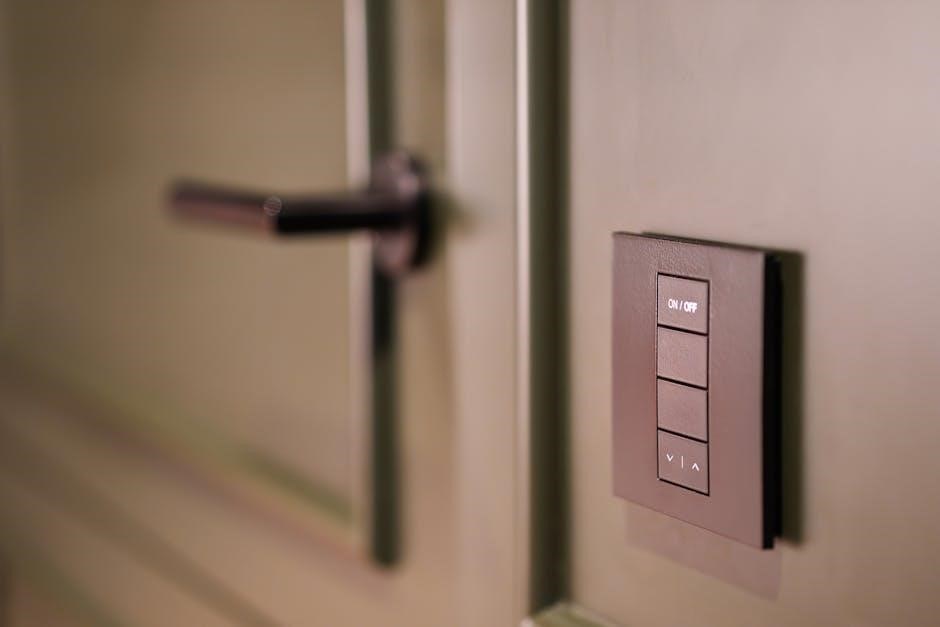honeywell light switch timer instructions
The Honeywell Light Switch Timer offers convenient control over home lighting, combining programmable scheduling with manual and automatic modes for enhanced energy efficiency and security.
Its intuitive design allows users to set custom on/off times, while compatibility with various bulb types ensures versatility in different lighting setups, making it a practical solution for modern homes.
Overview of Honeywell Light Switch Timer
The Honeywell Light Switch Timer is a programmable device designed to automate and control home lighting efficiently. It offers 7-day programming, allowing users to set custom on/off schedules for their lights. With three operating modes—manual, automatic, and random—this timer provides flexibility and convenience. The built-in LCD screen displays time and status, making it easy to manage settings. Designed to be energy-efficient, it helps reduce electricity consumption and enhances home security with its random mode. Compatible with various light types, this timer is a practical solution for modern households seeking to optimize their lighting system.
Importance of Using a Programmable Timer
Importance of Using a Programmable Timer
A programmable timer like the Honeywell Light Switch Timer is essential for optimizing home lighting. It allows users to schedule lights to turn on/off automatically, saving energy by reducing unnecessary usage. This feature also enhances security by simulating occupancy, deterring potential intruders. Additionally, it provides convenience by eliminating the need to manually control lights daily. By automating lighting, users can enjoy consistent operation and peace of mind. The timer’s programmable nature ensures lights function according to a set plan, making it ideal for busy households or those seeking to streamline their daily routines.
Brief History of Honeywell in Home Automation
Honeywell has a long-standing legacy in home automation, dating back to its early innovations in heating systems. Over the years, the company expanded into security, energy management, and smart home solutions. Honeywell’s commitment to innovation led to the development of programmable timers and switches, enhancing home convenience and efficiency. The introduction of the Honeywell Light Switch Timer reflects this evolution, offering users precise control over lighting schedules. By integrating technology with everyday needs, Honeywell continues to be a pioneer in home automation, making modern living smarter and more energy-efficient.
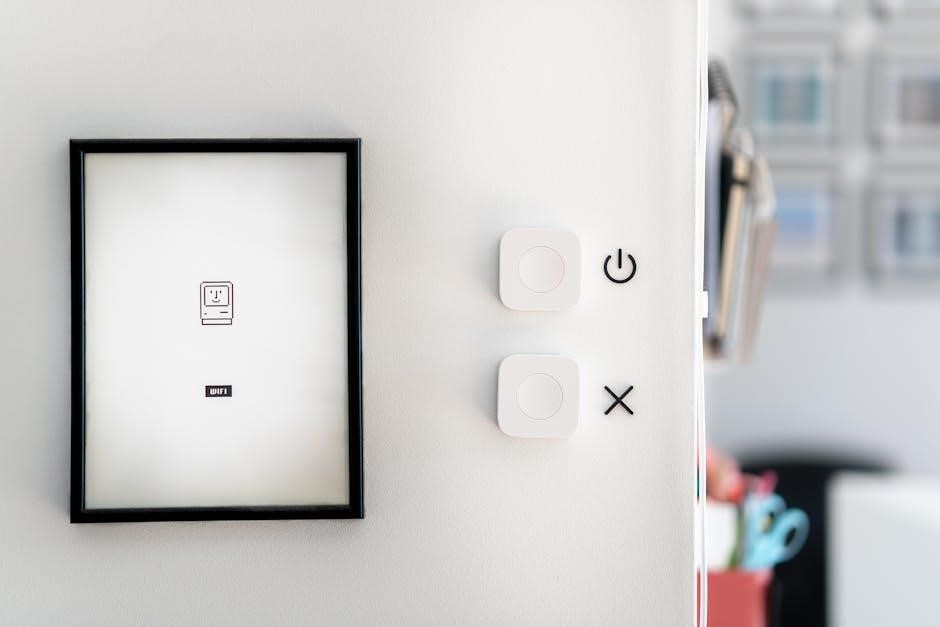
Features of Honeywell Light Switch Timer
The Honeywell Light Switch Timer features 7-day programming, manual-automatic-random modes, compatibility with various bulbs, an LCD display, and energy-saving benefits, enhancing home automation convenience.
7-Day Programming Capability
The Honeywell Light Switch Timer allows for 7-day programming, enabling users to set custom on/off schedules for each day of the week. This feature provides flexibility and convenience, letting homeowners tailor their lighting preferences to match their daily routines. Whether it’s automating lights to turn on at sunrise or off at bedtime, the 7-day programming ensures consistent and personalized control. This capability is particularly useful for maintaining a secure and energy-efficient home environment throughout the week.
Manual, Automatic, and Random Modes
Manual, Automatic, and Random Modes
The Honeywell Light Switch Timer offers three distinct operating modes to suit different needs. Manual mode allows for direct control, letting users turn lights on or off instantly without affecting programmed settings. Automatic mode follows a pre-set schedule, ensuring lights operate according to the programmed times. Random mode enhances security by randomly turning lights on and off, creating the illusion of occupancy. These modes provide flexibility, convenience, and peace of mind, catering to various lifestyles and preferences while maintaining energy efficiency and home safety.
Compatibility with Different Light Types
The Honeywell Light Switch Timer is designed to work with various lighting types, ensuring versatility for different home setups. It is compatible with incandescent, halogen, LED, and CF bulbs, making it a versatile solution for modern lighting needs. However, certain models may not support fluorescent or smart bulbs without additional components. Always check the product specifications to ensure compatibility with your specific lighting system; This adaptability allows users to integrate the timer seamlessly into their existing home lighting configuration, enhancing convenience and energy efficiency without compromising functionality.
LCD Screen for Time and Status Display
The Honeywell Light Switch Timer features an LCD screen that clearly displays the current time, day, and load status. This screen provides real-time feedback, making it easy to monitor and adjust settings. The LCD display also shows the operating mode, whether it’s manual, automatic, or random, ensuring users are always informed. With a backlit design, the screen remains visible in low-light conditions, enhancing usability. This feature simplifies programming and troubleshooting, allowing users to quickly verify schedules and statuses without confusion. The clear and concise display ensures a user-friendly experience for all.
Energy-Saving Benefits
Energy-Saving Benefits
The Honeywell Light Switch Timer provides significant energy-saving benefits by automating lighting schedules and reducing manual oversight. By programming specific on/off times, users can avoid leaving lights on unnecessarily, cutting energy waste. The timer’s ability to turn lights off automatically, even when forgotten, ensures consistent energy conservation. This feature not only lowers utility bills but also extends the lifespan of light bulbs by preventing overuse. The energy-saving benefits are further enhanced by compatibility with various bulb types, including energy-efficient LEDs and CFLs, making it a practical solution for eco-conscious homeowners seeking to reduce their environmental impact and save on energy costs.

Installation Guide
Install the Honeywell Light Switch Timer by turning off power, removing the old switch, and connecting wires to the timer. Secure it with screws and restore power.
Use a screwdriver and wire strippers; ensure wires are properly connected. Turn off power at the circuit breaker before starting for safety and accurate installation.
Tools and Materials Needed
Tools and Materials Needed
To install the Honeywell Light Switch Timer, ensure you have a screwdriver, wire strippers, and a voltage tester for safety. A ladder may be necessary for high switches.
Gather the timer unit, mounting screws, and any additional wiring connectors. Turn off power at the circuit breaker before starting to avoid electrical hazards. Ensure all tools are within reach for efficient installation.
Step-by-Step Installation Process
Step-by-Step Installation Process
Turn off the power to the light switch at the circuit breaker before starting. Verify the power is off using a voltage tester for safety.
Remove the old switch from the wall, carefully pulling out the wires. Disconnect the wires from the old switch.
Connect the wires to the Honeywell timer according to the wiring diagram. Ensure proper connections for live, load, and ground wires.
Mount the timer to the wall using the provided screws. Tighten securely without over-tightening.
Restore power and test the timer by toggling between modes to ensure proper functionality.
Wiring Diagrams and Precautions
Refer to the Honeywell timer’s wiring diagram for precise connections. Identify live, load, and ground wires, ensuring correct terminals are used. Turn off power at the circuit breaker before starting work.
Avoid connecting wires improperly, as this can damage the timer or cause electrical hazards. Use a voltage tester to confirm power is off. Ground wires must be securely attached for safety. For 3-way installations, follow the provided diagram to connect traveler wires correctly. If unsure, consult a licensed electrician. Proper wiring ensures reliable operation and prevents potential risks. Always follow manufacturer guidelines for a safe and successful installation.

Programming the Timer
Set the time and date first. Create a weekly schedule with specific on/off times. Use automatic mode for convenience or manual mode for direct control.
Setting the Time and Date
Setting the Time and Date
Start by setting the correct time and date on your Honeywell timer, as this ensures all programmed schedules operate accurately. Use the LCD screen to navigate through the menu. Press the main button to cycle through options, and adjust using the arrows. Once set, the timer will synchronize all programmed events with the correct time, ensuring reliability. Proper time and date configuration is essential for automatic and scheduled operations to function effectively. Failure to set these may result in incorrect timer behavior. Always refer to the manual for specific button functions and sequences to avoid errors during setup.
Creating a Weekly Schedule
Creating a Weekly Schedule
Program your Honeywell timer by creating a weekly schedule with up to 7 on/off events per day. Use the LCD screen to select each day of the week and set specific times for your lights to turn on or off. Choose between manual, automatic, or random modes to customize your lighting preferences. The timer allows you to program different settings for each day, ensuring flexibility and convenience. Once programmed, the timer will automatically execute your schedule, providing consistent control over your home’s lighting; This feature is ideal for maintaining a routine or simulating occupancy for security purposes.
Setting Sunset and Sunrise Times
Setting Sunset and Sunrise Times
To set sunset and sunrise times on your Honeywell Light Switch Timer, navigate to the time settings menu. Choose your location to enable automatic adjustments based on local sunrise and sunset times. Enter the correct date and time to ensure accuracy; The timer may automatically adjust for daylight saving time, eliminating the need for manual changes. Test the settings to confirm the lights turn on and off as expected. This feature enhances energy efficiency and provides seamless control over your home’s lighting.
Adjusting Default Settings
Adjusting Default Settings
To customize your Honeywell Light Switch Timer, access the settings menu by pressing and holding the appropriate button. Navigate to the default settings section to modify predefined values such as automatic shutoff times or lighting schedules. Use the up/down arrows to adjust the settings to your preferred values. After making changes, save the new settings to ensure they are retained. This feature allows you to tailor the timer’s behavior to your specific needs, enhancing convenience and energy efficiency. Regularly review and update default settings to maintain optimal performance and adapt to changing routines or preferences. Personalization ensures the timer functions precisely as desired.
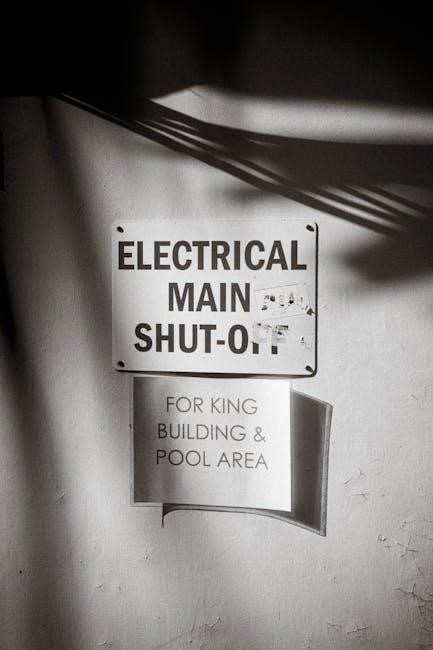
Operating Modes
Honeywell Light Switch Timers offer three distinct modes: Manual, Automatic, and Random. These modes provide flexibility for controlling lights, ensuring convenience, energy efficiency, and enhanced home security features.
Manual Mode Functionality
Manual Mode Functionality
In Manual Mode, the Honeywell Light Switch Timer operates like a traditional on/off switch, allowing users to control their lights directly without adhering to a programmed schedule. This mode is ideal for moments when you need immediate control over your lighting, offering flexibility and ease of use. The manual override feature ensures that you can turn lights on or off as needed, while still maintaining the programmed settings for automated operation. This dual functionality makes it a versatile option for various lighting preferences and situations.
Automatic Mode Operation
Automatic Mode Operation
In Automatic Mode, the Honeywell Light Switch Timer follows a preset schedule, turning lights on and off at specific times. This mode is ideal for maintaining a consistent lighting routine without manual intervention. The timer can be programmed to activate lights at sunrise or sunset, ensuring convenience and energy efficiency. Default settings often include turning lights on at sunset and off at 11 PM, but these can be customized to suit your preferences. Automatic Mode is perfect for busy households or for creating a seamless lighting experience, and it works seamlessly with LED and CF bulbs for optimal performance.
Random Mode for Security
Random Mode for Security
The Random Mode on the Honeywell Light Switch Timer enhances home security by simulating human activity through unpredictable lighting patterns. This mode is especially useful when the house is unoccupied, as it creates the illusion of someone being home. By randomly turning lights on and off within a set period, it deters potential intruders from targeting an empty property. The feature is fully automated and does not require a preset schedule, making it an effective and hassle-free way to boost security. It works seamlessly with various bulb types, including LED and halogen, ensuring reliable operation and peace of mind for homeowners.
Energy Efficiency and Savings
The Honeywell Light Switch Timer optimizes energy use by automating lighting schedules, reducing unnecessary consumption. Its programmable features ensure lights operate only when needed, lowering utility bills and environmental impact.
How the Timer Reduces Energy Consumption
How the Timer Reduces Energy Consumption
The Honeywell Light Switch Timer reduces energy consumption by automating lighting schedules, ensuring lights are on only when needed. Its programmable features prevent unnecessary usage, and the automatic shutoff for forgotten lights further minimizes waste. Additionally, the timer’s ability to optimize on/off times based on sunset and sunrise aligns lighting usage with natural daylight, reducing reliance on artificial light. This smart automation not only cuts energy bills but also extends bulb life, making it an eco-friendly and cost-effective solution for home lighting management.
Calculating Potential Energy Savings
Calculating Potential Energy Savings
The Honeywell Light Switch Timer helps estimate energy savings by automating lighting schedules, reducing unnecessary usage. By programming specific on/off times, users can avoid leaving lights on longer than needed. The timer’s automatic shutoff feature for forgotten lights further prevents energy waste. Additionally, the ability to optimize lighting based on sunset and sunrise times ensures lights are only on when natural light is insufficient. This tailored control allows homeowners to calculate and achieve significant energy savings, especially when paired with energy-efficient bulb types like LED or halogen, enhancing overall efficiency and lowering utility bills over time.
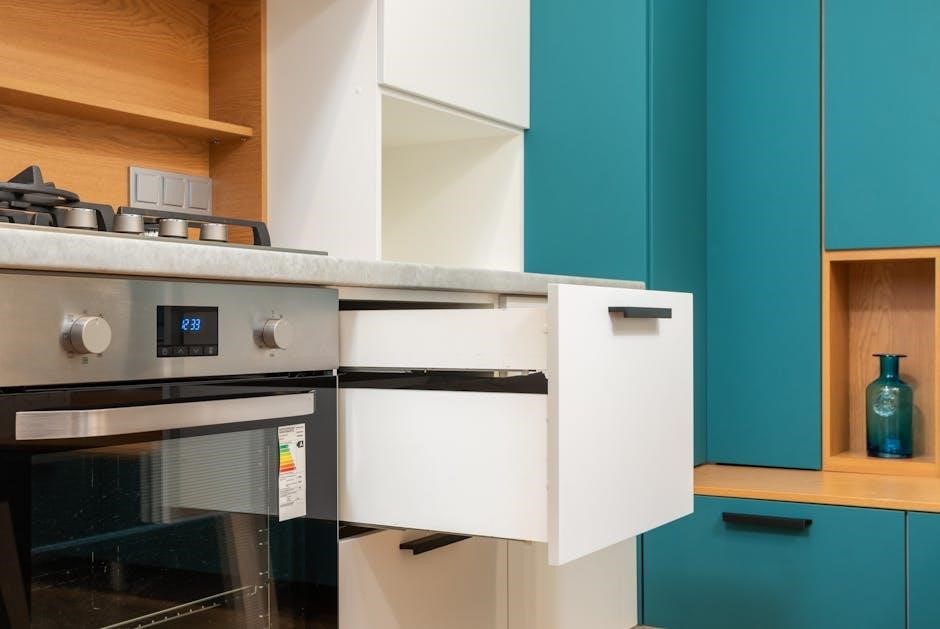
Compatibility and Usage
The Honeywell Light Switch Timer is compatible with single-switch and 3-way installations, supporting various bulb types, including LED, incandescent, and halogen, ensuring versatile and efficient lighting control.
Compatible Bulb Types
Compatible Bulb Types
The Honeywell Light Switch Timer is designed to work seamlessly with a variety of bulb types, including LED, incandescent, and halogen. This versatility ensures that users can maintain their preferred lighting aesthetic without compromising functionality. LED compatibility is particularly advantageous, offering energy efficiency and longer bulb life. Incandescent bulbs provide traditional warmth, while halogen bulbs deliver crisp, white light. The timer’s broad compatibility makes it a practical choice for diverse lighting setups, allowing homeowners to automate their lighting systems without the need for bulb replacement.
Usage in Single-Switch vs. 3-Way Installations
Usage in Single-Switch vs. 3-Way Installations
The Honeywell Light Switch Timer is adaptable for both single-switch and 3-way installations, providing flexibility for different home setups. In single-switch configurations, it operates as a standard wall switch with programmable scheduling. For 3-way installations, it integrates seamlessly with additional switches to control lighting from multiple locations. This versatility ensures that users can enjoy the timer’s advanced features regardless of their home’s wiring setup. The timer’s compatibility with both configurations makes it a universal solution for automating lighting systems in various residential environments, enhancing convenience and efficiency.
Safety and Security Features
The Honeywell Light Switch Timer features automatic shutoff for forgotten lights and random mode for security, enhancing both safety and energy efficiency across compatible bulb types.
Automatic Shutoff for Forgotten Lights
Automatic Shutoff for Forgotten Lights
The Honeywell Light Switch Timer includes an automatic shutoff feature, turning lights off at a default time of 11:00 PM if not manually adjusted. This prevents energy waste and enhances security by ensuring lights aren’t left on unnecessarily. The feature is especially useful for forgetful users or those who prefer hands-off management. It integrates seamlessly with the timer’s programming capabilities, allowing for customized shutoff times while maintaining convenience. This function not only saves energy but also adds a layer of safety and reliability to home lighting systems, making it a practical solution for everyday use.
Security Benefits of Random Mode
Security Benefits of Random Mode
The Random Mode on the Honeywell Light Switch Timer enhances home security by randomly turning lights on and off during predetermined periods. This creates the illusion of occupancy, deterring potential intruders. Ideal for when you’re away, it mimics human activity, making your home appear lived-in even when it’s not. This feature complements the timer’s automatic shutoff and programmable scheduling, offering an additional layer of protection. By integrating randomness into your lighting routine, you can enjoy peace of mind knowing your home is more secure, all while maintaining energy efficiency and convenience.

Troubleshooting Common Issues
Common issues include malfunctioning timers or compatibility problems. Check connections, reset the timer, or consult the manual for specific solutions to ensure proper functionality and resolve errors effectively.
Resolving Timer Malfunctions
Resolving Timer Malfunctions
To address timer malfunctions, first ensure all connections are secure and the device is powered correctly. If issues persist, reset the timer by removing and reinstalling the batteries. Check for firmware updates or consult the user manual for troubleshooting steps. If the timer still doesn’t function properly, contact Honeywell customer support for assistance or consider replacing the unit if it’s no longer under warranty. Regular maintenance and updates can help prevent future malfunctions and ensure optimal performance. Always follow manufacturer guidelines for repairs and replacements to maintain safety and efficiency.
Addressing Compatibility Problems
Addressing Compatibility Problems
Ensure the Honeywell Light Switch Timer is compatible with your lighting setup. Verify bulb types, as it works with incandescent, halogen, LED, and CF bulbs. For 3-way installations, check compatibility with multiswitch configurations. If issues arise, consult the manual or Honeywell support to confirm compatibility. Resetting the timer or updating settings may resolve conflicts. Always follow installation guidelines to avoid mismatches. Proper compatibility ensures smooth operation and optimal performance of the timer with your lighting system. Addressing these issues early prevents operational disruptions and enhances overall functionality.
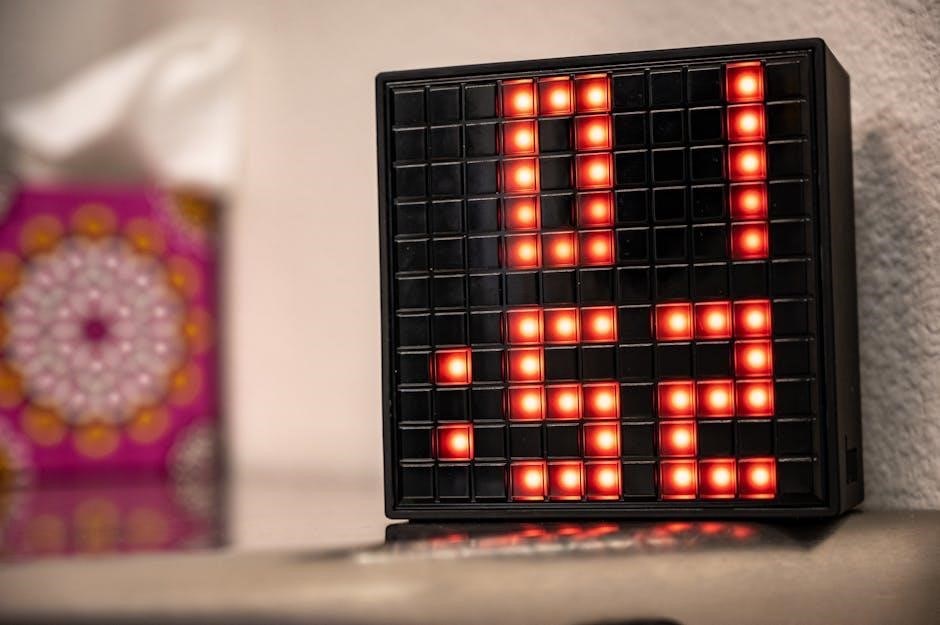
Advanced Settings and Customization
Customize on/off times and adjust sensitivity for tailored control. Advanced settings enhance functionality and efficiency, ensuring personalized automation for your lighting needs.
Customizing On/Off Times
Customizing On/Off Times
Customizing on/off times on the Honeywell Light Switch Timer allows for precise control over your lighting schedule. Users can set specific times for lights to turn on or off, ensuring convenience and energy efficiency. The timer supports up to 7-day programming, enabling unique schedules for each day of the week. Manual override is also available, letting you adjust settings without disrupting programmed times. This feature is ideal for maintaining flexibility while automating your lighting routine. The ability to tailor on/off times enhances the overall functionality, making it suitable for various household needs and preferences. Energy conservation and security are further optimized through these customizable settings.
Adjusting Timer Sensitivity
Adjusting Timer Sensitivity
Adjusting the sensitivity of the Honeywell Light Switch Timer ensures precise control over lighting operations. Sensitivity settings allow users to fine-tune how the timer responds to manual inputs or automatic triggers, such as daylight changes for sunset and sunrise modes. This feature prevents accidental activations and ensures smooth transitions between on/off states. Users can access sensitivity adjustments through the timer’s advanced settings menu, typically found under customizations. Proper calibration enhances the timer’s performance, ensuring lights operate reliably and efficiently. This adjustment is particularly useful for optimizing energy savings and maintaining consistent lighting schedules, making it a valuable feature for tailored home automation. Sensitivity tuning is straightforward and requires minimal effort for optimal results.

Maintenance and Care
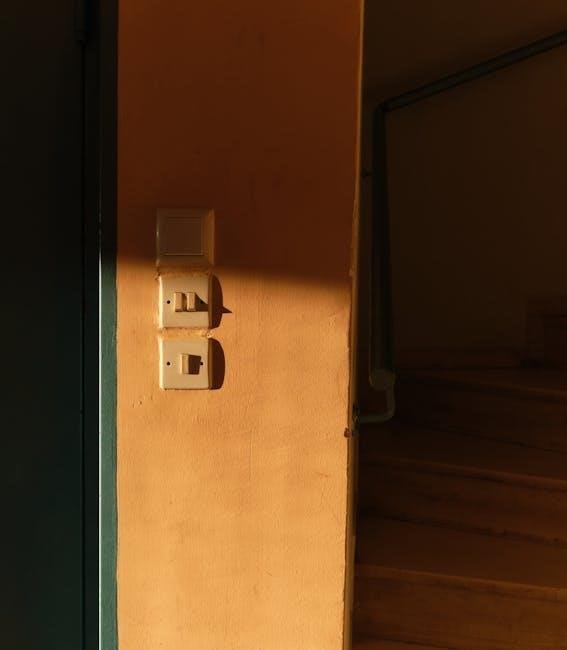
Maintenance and Care
Regularly clean the timer’s LCD screen with a soft cloth to ensure visibility. Check battery levels periodically to prevent unexpected malfunctions and maintain optimal performance.
Cleaning the Timer
Cleaning the Timer
Regular cleaning of the Honeywell Light Switch Timer ensures optimal functionality and longevity. Use a soft, dry cloth to gently wipe the LCD screen and exterior surfaces.
Avoid using harsh chemicals, abrasive materials, or excessive moisture, as these could damage the device. For stubborn stains, lightly dampen the cloth with water, but ensure no moisture seeps into the timer.
Pay special attention to the buttons and crevices, where dust may accumulate. Cleaning should be done periodically to maintain clarity and responsiveness of the interface.
After cleaning, thoroughly dry the timer with a soft cloth to prevent any moisture-related issues. Regular maintenance helps preserve performance and ensures precise control over your lighting system.
Replacing Batteries
Replacing Batteries
To maintain uninterrupted operation, replace the Honeywell Light Switch Timer’s batteries when the low-battery indicator appears on the LCD screen. Use a CR2032 lithium battery or equivalent.
Open the battery compartment located on the back of the timer using a screwdriver. 2. Remove the old batteries and discard them properly. 3. Insert the new batteries, ensuring correct polarity. 4. Close the compartment securely.
After replacing, press any button to test functionality. Dispose of old batteries responsibly. This simple process ensures your timer continues to operate smoothly and maintain your lighting schedule effectively.
The Honeywell Light Switch Timer enhances home automation, offering energy efficiency, convenience, and security through programmable scheduling, manual overrides, and random modes, ensuring optimal lighting control and user satisfaction.
The Honeywell Light Switch Timer offers 7-day programmable scheduling, manual, automatic, and random modes, ensuring flexibility and energy efficiency. Its LCD screen displays time and status, making it user-friendly. Compatible with various bulb types, including LED and halogen, it provides versatile lighting control. The timer’s energy-saving features reduce consumption by automating on/off times, while random mode enhances security. Designed for both single-switch and 3-way installations, it adapts to different home setups. With easy programming and manual overrides, it balances convenience and customization, making it a practical solution for modern homes seeking efficient and secure lighting management.
Final Tips for Optimal Use
Regularly review and update your programmed schedules to align with seasonal changes or lifestyle adjustments. Use the random mode during vacations to simulate occupancy, enhancing home security. For energy efficiency, ensure timers are set to turn off lights during daylight hours when natural light is sufficient. Additionally, check bulb compatibility to maximize performance and avoid overheating issues. Finally, clean the LCD screen periodically to maintain clarity and replace batteries as needed to prevent programming loss.
